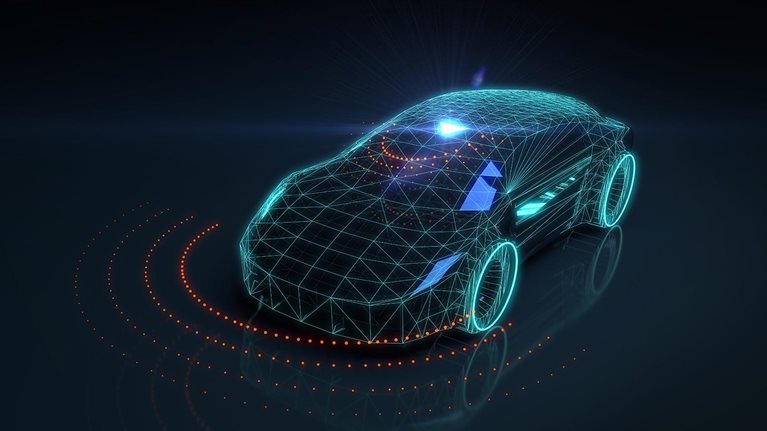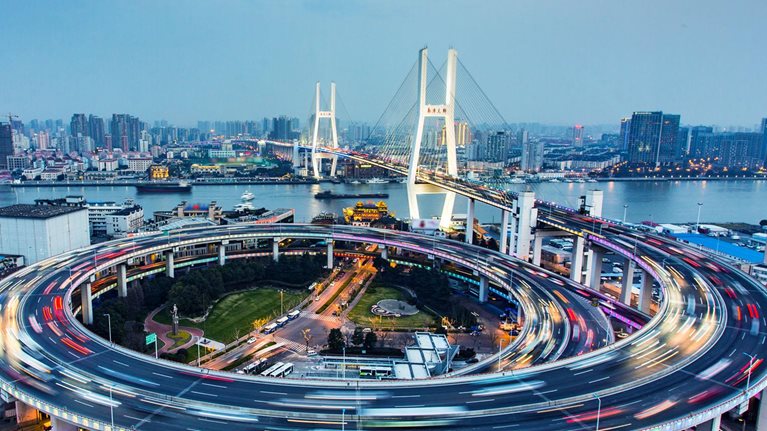Self-driving cars could steer China’s automotive industry into the passing lane. From driverless taxis to automated cargo trucks, autonomous vehicles (AVs) will change the nature of on-road driving and, in the process, revolutionize the automotive and mobility industries. Within this mix of opportunity and uncertainty, we believe AV players (from components vendors to mobility service providers) could earn trillions in revenues in China.
Fundamentally transforming mobility
McKinsey research suggests autonomous vehicles could, at some point, take over most of the automotive market in China. For instance, industry respondents to our survey indicate passenger vehicles used for mobility services such as “robo-taxis” will see a peak adoption rate of 62 percent, followed by private premium vehicles (51 percent) and private mass-market cars (38 percent). Mobility services will lead due to the autonomous vehicle’s expected increased utilization (close to 24/7 operation) and lower labor costs (no drivers). The same rationale puts city buses at 69 percent adoption and commercial vehicles (CVs) at 67 percent.
Autonomous vehicles will likely shift a substantial share of the mobility market value away from products (that is, buying vehicles) and toward services (that is, paying for transportation per mile). This “mobility-as-a-service” (MaaS) transformation suggests dramatic changes ahead for vehicle sales volumes, business models, and the capabilities companies will need to thrive in this new environment. In China, we believe fully autonomous vehicles (SAE Level 4 and above) will see mass deployment in nine or ten years.
These shifts will change the rules of the game across the entire mobility space, as software and data become fundamental differentiators when building and operating cars. As such, the mobility sector will become ground zero for a convergence of industries that include automotive, transportation, software, hardware, and data services.
Today’s automakers focus on selling new cars, transportation companies on providing services, and technology players on supplying hardware and software to automakers. In the future, new business models might emerge. Technology players could buy vehicles from automakers to provide services direct to consumers. Alternatively, automakers might vertically integrate in services and software development (as leading players are already doing today). Players in these sectors must reconcile their differences in product life cycles (for example, three to four years for automotive, weeks to months for software) and business models (for instance, products versus services) to compete and cooperate effectively with each other.
Clearly, many companies already have active autonomous vehicle strategies, including technology players such as Baidu, Tencent, and Waymo and automakers such as GM, SAIC Motor, and Tesla. However, given the industry’s dynamic, fast-moving nature, players need to refresh their strategies constantly.
Understanding how China fits in
China has the potential to become the world’s largest market for autonomous vehicles. In our base forecast, such vehicles could account for as much as 66 percent of the passenger-kilometers traveled in 2040 (Exhibit 1), generating market revenue of $1.1 trillion from mobility services and $0.9 trillion from sales of autonomous vehicles by that year. In unit terms, that means autonomous vehicles will make up just over 40 percent of new vehicle sales in 2040, and 12 percent of the vehicle installed base.

Autonomous vehicles could solve major infrastructure problems
In 2009, China passed the United States to become the world’s largest and most important automotive market, going on to consume nearly 30 million light vehicles in 2018, almost 70 percent more than the United States. This continued explosive growth is overtaxing the country’s automotive-related infrastructure, driving increased traffic congestion and pollution. Beijingers spend an average of 1.3 hours every day commuting—more than three times as much as the average US commuter. Autonomous vehicles will offer a potential solution to some of these infrastructure challenges. In the realm of shared mobility, they could reduce the number of vehicles on the road and free former drivers to work or relax en route. If powered by green electricity or hydrogen, they could also help reduce local vehicle emissions.
However, a complex environment could slow initial uptake of AVs
In the short term, given China’s complex traffic environment, autonomous vehicles must adapt to road conditions and aggressive driving behaviors, which could slow adoption. However, a review of traffic severity worldwide reveals China’s problem as one of degree, not kind. Western cities from downtown New York to Rome have similarly dense populations and levels of mixed traffic.
Consequently, the technology solution in China for autonomous driving will not differ much from those in other nations. Required computing platforms will likely conform because existing platforms feature enough “buffer” capacity to handle the more complex computing tasks required to analyze objects on Chinese roads. Sensor configurations would probably not change from region to region because current setups can cover all critical directions across very different driving use cases.
Would you like to learn more about the McKinsey Center for Future Mobility?
What is different in China involves the country’s highly complicated signage, with traffic lights and road signs not yet fully standardized. Likewise, right-of-way issues resulting from the failure of Chinese drivers to follow road rules strictly add a major element of uncertainty to programing and “training” requirements for autonomous vehicles. Consequently, the need to optimize AV decision algorithms for Chinese roads could take more effort and training, which could add roughly two to three years to the adoption timeline compared with the United States. As such, the first applications of autonomous vehicles in constrained environments might begin in the next five years, but mass adoption will likely occur only after 2027, as it will require the technology to address the majority of conditions of urban and suburban driving (Exhibit 2).

While the core algorithm for the operation of autonomous vehicles is largely the same on a global basis, operating in China will require additional data and testing. For example, developers need to collect and input local traffic data to resolve the issue of unique and ununified road signage. They must also optimize motion planning through road testing so the algorithm can learn to deal with issues caused by the relentless driving styles of some Chinese motorists.
Still, longer-term prospects appear promising
In the long term, China will likely emerge as the world’s largest market for autonomous vehicles. In fact, the Chinese automotive market is already adopting MaaS at a rapid rate. For example, cars sold to provide mobility services today represent about 10 percent of China’s total cars sales, and the country’s mobility-services market has grown at double-digit rates over the past several years (Exhibit 3). This familiarization should translate into strong demand for mobility via autonomous vehicles in the long term.

Reaching an adoption inflection point
We developed a proprietary sizing model to forecast China’s market for autonomous vehicles. The model takes a use-case approach, which analyzes the developments required for a specific category of autonomous vehicle, such as robo-taxis or automated trucks, to succeed in the marketplace. We surveyed more than 40 industry experts across the AV ecosystem and received feedback and advice from an external advisory board that included AV experts and executives from automakers, Tier-1 suppliers, technology companies, and mobility service providers. We learned the experts believe technology, rather than regulation, will likely hold back the adoption of autonomous vehicles. We chose two commercialization speeds: fast adoption and slow breakthroughs. Based on that analysis, we believe 2025–30 will represent an inflection point for adoption of autonomous vehicles, with the broad timespan dependent on the usage model and city-level driver economics.
Exhibit 4 shows the cost crossover analysis for a fully battery-electric vehicle used for mobility services as a robo-taxi. The major cost drivers include the vehicle’s depreciation, the driver’s cost, maintenance, insurance, and electricity (fuel). They do not include operational or management fees for running a mobility service fleet. The replacement of human drivers in autonomous vehicles will occur gradually due to safety and regulation considerations.

The cost of the total AV system (including sensors, computing platform, and software) should decrease rapidly after the technology matures beyond 2023, to approximately $8,000 in 2025. Once autonomous vehicles reach the crossover point, adoption will accelerate.
This inflection point is when, based on the functional robustness and cost curves of AV technologies, self-driven transport will reach economic parity with human-driven transport. In other words, the total cost per kilometer of an autonomous vehicle will roughly match that of a traditional car with driver. After this inflection point, demand for autonomous vehicles should rise steadily, depending on how the market develops. As this occurs, the potential for new players to seize control of the automotive value chain grows.
Industry profit pools to flow toward services and software
The advent of autonomous vehicles will expand the mobility profit pool in the Chinese autonomous vehicle industry by at least $60 billion compared with today’s value. Car sales will remain a large share of the profit pool in the overall value chain, at $50 billion to $60 billion. However, mobility services profits will grow to become 25 to 30 percent of the total profit pool (including vehicles, components, mobility services, and fleet management) and could exceed those of car sales, especially if the MaaS market were less competitive (for example, if government cooperated with mobility players). On the other hand, AV technology and system integration will produce $15 billion to $20 billion in profits, representing 50 to 60 percent of the total auto-components profit pool.
Profit pools will depend on the competitive environment. In one scenario, robo-taxis will be operating via local public/private joint ventures. In this case, MaaS could make up $50 billion to $55 billion—over a quarter of the $195 billion profit pool in China. In another scenario, if robo-taxis were operating in a much more competitive free-market environment, the mobility services segment would shrink significantly to $15 billion to $20 billion. Whichever case prevails, the larger point is that autonomous vehicles could create substantial value for the industry and thus have a major impact on profit pools.
Shaping a Chinese AV revolution
The market for autonomous vehicles in China will offer huge opportunities to players willing to shoulder the risks involved, from local Chinese automakers to multinational companies to tech giants and mobility businesses. To capture these opportunities, players can either develop a differentiating service connection to the end customers or control key parts of the AV technology. Identifying which elements of the technology hold long-term strategic value and their evolution over time will enable players to locate the high-value “soul” of the autonomous-driving machine.
Tech stacks will complement value chains
The emerging AV ecosystem differs from traditional automotive approaches because it focuses on the technology stack—a concept used in the high technology and computing industries (Exhibit 5).

The core elements of the technology stack include the sensors, the computing platform, software (including object detection and analysis as well as motion planning), system integration and validation, mapping, and location-based services (LBS). As such, it represents the core of an automobile’s autonomous drive system. That makes it a critical part of the vehicle to “own” for automakers, suppliers, technology companies, and others. It seems likely that the important elements of the stack will evolve over time, thus requiring companies in the segment to monitor and assess the potential disruptions linked to subsequent technology innovations as they occur.
Each tech stack layer has different critical success factors. For example, the sensor layer requires robust reliability and safety elements, as well as strong mass-production and production management capabilities to achieve necessary economies of scale. The algorithm and software layers require agile development skills and fast iteration capabilities to enable companies to work through training data to improve performance on a consistent basis. System integration and validation requires outstanding reliability and safety, and strong mass-production capabilities.
Building a Chinese tech stack
Of key interest to industry players is to what extent the Chinese stack will differ from that used in the rest of the world. The end state of this stack remains highly uncertain, as it depends on the competitiveness of different players and the regulatory environment. However, early indicators suggest that both global and locally developed solutions will emerge across the stack.
Economics will provide much of the answer here. Hardware components are most likely to benefit from the scale economics of global solutions. Sensors, cameras, lidar, and the computing platform require the same capabilities in China as in the rest of the world (and therefore benefit greatly from the scale impact of global solutions). Mapping, LBS, and data-cloud solutions will likely require heavy localization.
Some elements of a typical autonomous vehicle’s technology stack—LBS and data cloud, for example—currently face so-called “negative restrictions” (for example, limitations on foreign-company involvement) by the government. Our research suggests local players alone will have access to most location-based services, leaving foreign companies and joint ventures at a disadvantage. The same appears to hold true for China’s data cloud. That leaves the other five parts of the tech stack—the mobility services interface, the motion planning algorithm, connectivity functions, the central processing and graphics processing units, and sensors—currently open to foreign participation.
Surveys and interviews with experts in the automotive, mobility, and technology industries suggest Chinese players are at least two to three years behind international companies in the critical capabilities required for delivering the AV stack (Exhibit 6). In some cases, such as the computing platform and AV system integration, the Chinese automakers are more than ten years behind.

The Chinese government strongly supports local AV technology development, as shown by the establishment of multiple AV test zones, including Jiading in Shanghai and Xiong’an outside of Beijing. Initially positive, such support can help local players develop capabilities. Over time, however, the increasing drive toward localization could restrict competition in the sector (for example, hampering outsider abilities to operate locally or access local technology).
The venture-capital community and major internet players are investing heavily in China to close the global/local gap. Over the last five years, AV and component companies have received $7 billion in funding. Alibaba, Baidu, and Tencent have all invested in the sector by participating in funding rounds (for example, Baidu and Tencent with NIO, and Alibaba with Xpeng) and establishing partnerships (for instance, Alibaba with SAIC, Tencent with several OEMs, and Baidu with a wide range of players across the value chain as part of its Apollo ecosystem).

Riding China’s huge, high-flying car market
The large amounts of available capital noted above and the active involvement of the government will both actively help to shape the competitive landscape for autonomous vehicles in China. At the same time, to succeed, China’s AV industry must integrate itself deeply with global ecosystems to avoid reinventing the wheel.
This type of integration will be imperative for Chinese players of all kinds because high-level AV technology requirements are fundamentally similar and thus transferable across markets and regions. Additionally, international players often have considerable advantages regarding some elements of the AV technology stack due to their global reach and expertise. As with any new technology, efforts to standardize as many elements of self-driving technology as possible could pay immense dividends down the road, especially for underresourced local players in China.
Identifying winners and also-rans
Winning the AV race will require industry incumbents to step out of their comfort zones and fully engage with a variety of players across the value chain and throughout the technology stack. Technology giants and other outsiders must also adopt new strategies to make sure their technology offerings become core parts of any standardized autonomous vehicle solutions. Additionally, players might need to move into new segments of the value chain (for example, mobility). As a result, winning will require cooperation between local and multinational companies and along the value chain.
Several alliance models exist both across the AV technology stack (Exhibit 7) and between multinational and local players (Exhibit 8).


Preparing now for tomorrow’s self-driving realities
For automakers, high-tech companies, and mobility services providers competing in China, the AV phenomenon may seem a decade or two away, but deferring positioning strategies can rob players of both influence and degrees of freedom.
Winning this game will require companies to evaluate their entry strategies carefully, balancing the high risk involved against the potential value of becoming a leader in the largest long-term market for autonomous vehicles in the world. In China as well as globally, autonomy and MaaS present a challenging landscape for investors due to the technological uncertainty and lack of proven business models. Companies making large-scale bets on conventional driving technologies (which will generate the bulk of market volume for at least the next half-decade) need to balance their investments in the old and the new at the same time.
We have a few suggestions for players developing their AV strategy:
- Decide where to play. Make a clear decision regarding what parts of the AV tech stack make the most sense for your company, both in terms of control points and differentiation. Establish a business model compatible with the identified source of differentiation.
- Develop a road map to access the tech stack. Identify the link between your source of differentiation and the technology road map you need to deliver. Estimate the company’s capability gaps and the investments required to decide whether to develop the technology in-house or acquire the needed capabilities.
- Choose the right alliance and ecosystem. Determine your ecosystem and alliance strategy; no single player can deliver all the needed technology in the AV tech stack. At the same time, the AV value chain will differ from traditional ones. We believe going it alone is not an option. Instead, be ready to forge new partnerships and alliances as needed.
- Build organizational agility. Cultivate strategic and organizational agility so you can update your strategy and tactics to anticipate changes in market dynamics and react quickly to competitor or partner moves.
Beyond these four suggestions, multinational companies should consider creating a China-specific strategy with the flexibility to adapt their global models for China. That means developing the capacity to understand, respond to, influence, and shape what’s going on in the country—and to develop tech-stack solutions in response. Multinational players today are uniquely aware of both the opportunity in China and the uncertainties regarding the competitive dynamics and localization requirements. That said, building a “global plus local” strategy and execution engine will not be a trivial exercise.
Likewise, local players should assess what specific parts of the AV tech stack it makes sense for them to own versus those they should access through partnerships with multinational players (at the cost of partially giving away value and control). Today, most local automakers depend primarily on tech-stack components provided by global companies, and thus have only limited investments in the core technologies and integration capabilities. Such a strategy can work for fast followers, but to play a disruptive role, companies will need to control their own tech stacks.
Getting started
While an autonomous vehicle can drive itself, firing up a company’s AV strategy for China is more of a hands-on proposition. In addition to sorting through the traditional “where to play” and “how to play” questions, leaders need to make an unblinking assessment of the risks involved—both in being an industry leader and in waiting for others to lead the way. While such decisions are challenging under any circumstances, this one involves a trillion-dollar bet in China, home of the world’s largest and most dynamic car market. With stakes this high, players will need much more than luck to gain a winning position.


